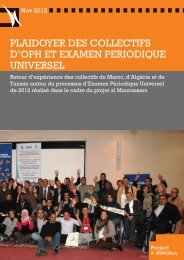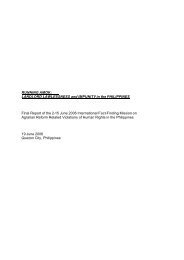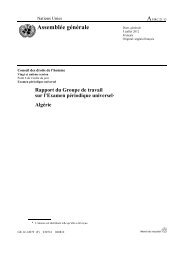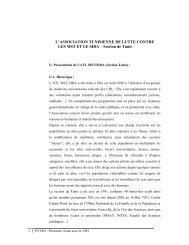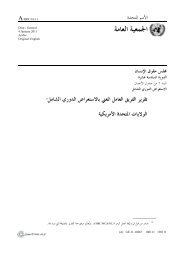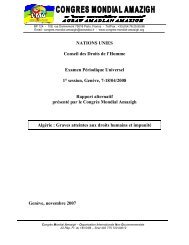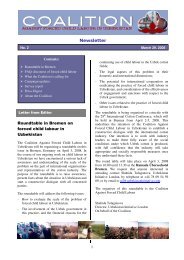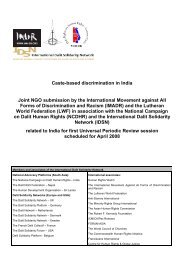Herding Cats and Sheep: Assessing State and Regional ... - UPR Info
Herding Cats and Sheep: Assessing State and Regional ... - UPR Info
Herding Cats and Sheep: Assessing State and Regional ... - UPR Info
- No tags were found...
You also want an ePaper? Increase the reach of your titles
YUMPU automatically turns print PDFs into web optimized ePapers that Google loves.
AbstractIncreasing attention is being focused on the utility of peer review processes in intergovernmentalorganizations. In 2008 the Universal Periodic Review (<strong>UPR</strong>) mechanism of theUnited Nations Human Rights Council (HRC) began functioning. This process in whichgovernments make recommendations to fellow UN member states on how to promote <strong>and</strong>protect human rights is a leading feature of the HRC, which succeeded the widely discreditedUN Commission on Human Rights (CHR). A key question confronting the HRC, <strong>and</strong> thebroader international community is whether the <strong>UPR</strong> is a fresh initiative which can succeed inbreaking free of past regionally-based gridlock <strong>and</strong> whether the <strong>UPR</strong> can spearhead greatereffectiveness of the HRC. Analysis based on an innovative rating of <strong>UPR</strong> recommendations bylevel of action requested shows some significant regional differentiation, compared to theprevious north-south dichotomy. The relatively more democratically-oriented governments inthe GRULAC (Latin American) <strong>and</strong> East European regions occupy middle ground betweenAfrica <strong>and</strong> Asia, <strong>and</strong> the Western European <strong>and</strong> Other (WEOG) regions in how they utilize the<strong>UPR</strong>. This regional differentiation suggests that the <strong>UPR</strong>, <strong>and</strong> by extension, the HRC, may beable to play a more positive role than the CHR.2
however, are by definition creations of the member states of the organization undertaking them,they all tend to be the products of consensus. This in turn means that they rely more on thecarrot of positive reinforcements <strong>and</strong> inducements rather than the stick of punitive measures. It isnot too soon, however, to analyze their functioning, <strong>and</strong> underst<strong>and</strong> the dynamics behind theiroperation. In the case of the <strong>UPR</strong> the importance of this assessment is heightened by twoupcoming events on the HRC calendar. First, the <strong>UPR</strong> experiment is critical to the fate of theHRC, the performance of which will be examined in 2011. Second, the next round of <strong>UPR</strong>reviews will begin in 2012; there is growing dem<strong>and</strong> for information about how it has functionedto date.The <strong>UPR</strong> mechanism is a key element of the HRC. The <strong>UPR</strong>’s stated purpose is topromote <strong>and</strong> deepen respect for human rights through the provision of feedback to member stateson their human rights performance. It is a process in which a small working group oversees thepreparation <strong>and</strong> presentation of information regarding country adherence to a range of humanrights criteria, <strong>and</strong> reports to the HRC as a whole. The HRC’s 47 members, who are elected bythe UN General Assembly, as well as other UN member states, then have an “interactivedialogue” during a <strong>UPR</strong> session in Geneva with representatives of the government of the <strong>State</strong>under Review (SuR) <strong>and</strong> make recommendations, which the SuR is then free to accept, reject,provide a general answer, or ignore. The <strong>UPR</strong> began activity in 2007; 48 countries are reviewedper year.This paper examines state behavior in the <strong>UPR</strong>. The underlying contextual question ishow effective is the United Nations Human Rights Council (HRC) in promoting human rightsaround the world? More specifically, does the Universal Periodic Review mechanism of theHRC contribute to the HRC’s m<strong>and</strong>ate to promote world-wide human rights? We examine the4
ecommendations process <strong>and</strong> consider what patterns exist in country <strong>and</strong> regional behavior. Indoing so we can determine whether new patterns of interaction are developing, or whether the<strong>UPR</strong> in reality reflects the continuance of the status quo.At its core the <strong>UPR</strong> represents a new <strong>and</strong> largely untested forum in which states makepolicy recommendations to each other. The multilateral context in which it functions is highlycomplex <strong>and</strong> sensitive. In part for exactly those reasons this topic represents an important casestudy in whether a universally-inspired initiative can be designed to help advance human rightsin real <strong>and</strong> concrete terms. To date there is only limited information <strong>and</strong> analysis about theactual functioning of the <strong>UPR</strong>, <strong>and</strong> virtually no related comparative analysis in the literature.The <strong>UPR</strong>’s importance within the HRC lies not only in its function, but also in itssymbolic value. How it fares, <strong>and</strong> how credibly its work is viewed, will impact considerably onperceptions of the HRC more broadly. Various stakeholders in the international community havebeen willing to give the HRC a trial period for it to develop a track record <strong>and</strong> “get its legs underit”. Increasingly, however, there is focus on its overall performance, <strong>and</strong> whether the HRC as awhole will mirror the weaknesses of the CHR, or prove to be a more effective organization.A frequently expressed statement amongst observers <strong>and</strong> participants in the <strong>UPR</strong>process is that by contrast to other functions of the HRC <strong>and</strong> the UN General Assembly whereregional affiliations <strong>and</strong> loyalties “lock-in” North-South conflict, the <strong>UPR</strong> recommendationsprocess emphasizes bilateral, state-to-state relations. This view holds that states have greaterfreedom to make decisions <strong>and</strong> act apart from regional affiliation. If this is true, a successful<strong>UPR</strong> process could serve as an example to create new <strong>and</strong> potentially more positive dynamics ofinteraction between states in the UN system.5
This paper examines a database of 6,077 <strong>UPR</strong> recommendations made in the first fiveHRC sessions devoted to the <strong>UPR</strong>, which took place in 2008 <strong>and</strong> 2009. 3Underlying questionsare: How do states approach this process? Do they utilize it as a way to improve human rights?Or is it a “you scratch my back <strong>and</strong> I’ll scratch yours” exercise, in which tough issues are largelyavoided? Do states actively critique each other through their recommendations, or do they take asofter, longer-term approach, on the grounds that positive reinforcement will eventually lead tohuman rights improvement?This database contains several unique features. It permits aggregation of information <strong>and</strong>results, which can lead to a wide range of analysis. It allows analysis by recommending country<strong>and</strong> regional group, not just by the <strong>State</strong> under Review <strong>and</strong> its regional group. It also includescharacterization of each recommendation by action requested, the type of responses, <strong>and</strong> theissue(s) addressed.The database includes a number of sections. Categories A-F contains factual information<strong>and</strong> are self-explanatory. By contrast, categories G-I, which are discussed in greater detail below,are more interpretative in nature <strong>and</strong> reflect analysis <strong>and</strong> judgments based on largely objectivecriteria (all quality-controlled by a second coder) which should be generally replicable. Forillustrative purposes I include in parentheses here an actual example from the database.Category:A. Session Number (5)B. <strong>State</strong> under Review – SuR (Afghanistan)C. <strong>Regional</strong> Group of the SuR (Asia, OIC)D. <strong>State</strong> making Recommendation (Austria)3This database is accessible at http://www.upr-info.org/database/.6
Examples:- Seek contributions from the international community in the Government’s efforts to promoterights (Ghana to Botswana, Session 3).- Share its experiences <strong>and</strong> best practices with other countries in establishing national legislation<strong>and</strong> mechanisms <strong>and</strong> pursuing international cooperation to curb human trafficking (Philippines toUnited Arab Emirates, Session 3).Category 2 – Recommendations emphasizing continuity in actions <strong>and</strong>/or policies (other verbs in thiscategory include continue, persevere, maintain)Examples:- Continue its efforts to develop the work of its national institution for human rights, as aneffective human rights watchdog (Egypt to Bangladesh, Session 4).- Continue the efforts to combat trafficking in persons with a special emphasis on women <strong>and</strong>children (Canada to Japan, Session 2).Category 3 – Recommendations to consider change (consider, reflect upon, review, envision)Examples:- Consider subsequent measures towards the complete abolition of the death penalty (Switzerl<strong>and</strong>to Cuba, Session 1).- Consider becoming party to the International Convention on the Protection of the Rights of AllMigrant Workers <strong>and</strong> Members of Their Families (Azerbaijan to Mauritius, Session 4).Category 4 – Recommendations of action that contains a general element (take measures or stepstowards, encourage, promote, intensify, accelerate, engage with, respect, enhance)8
Examples:- Further improve the professionalism of the police force (Netherl<strong>and</strong>s to Barbados, Session 3).- Take the necessary steps to reduce discriminatory practices <strong>and</strong> violence against women(France to Mali, Session 2).Category 5 – Recommendations of specific action (undertake, adopt, ratify, establish, implement,recognize –in international legal sense).Examples:- Abolish the death penalty (Chile to Burkina Faso, Session 3).- Adopt legislative measures to outlaw domestic violence if it has not done so already (SouthAfrica to Russian Federation, Session 4).When there is a perfectly even rationale for two different actions in a recommendation,emphasis is generally placed on the first one. 5 In few cases, depending upon the context, therecommendation has been split into two.I acknowledge that the level of progression in terms of costs from Category 1 to Category5 is not necessarily axiomatic. For example, most recommendations in the second category ofcontinuity tend to be hortatory in nature, express a positive view of steps taken by the SuR, <strong>and</strong>require no additional action beyond which that already being taken. Some Category 2recommendations, however, may in fact be very challenging to implement. In the context of agovernment which is making significant human rights reforms in the face of entrenchedopposition, for example, simply a recommendation to continue on that reform process can proveto be important <strong>and</strong> useful. Similarly, while most Category 5 recommendations appear to be5See, for example, Cuba recommendation to Bahamas in Session 3 on continuing positive efforts <strong>and</strong>sharing experiences.9
significant <strong>and</strong> require substantive actions on the part of the SuR, others may not be veryimportant, given the context in which they are being made.Responses to Recommendations (H)The four types of responses by the SuR include Accepted, Rejected, No Response, <strong>and</strong>General Response. While the first three are self-explanatory, general responses are mainlycomments on the subject matter recommendation, without clearly stating acceptance or rejection.Further research on this issue is needed, but many of these responses appear to be de factorejections of recommendations without so stating officially.Typology of Issues (I)This category provides recommendations by issue raised. These include, inter alia,women’s rights, children, torture, justice, migrants, death penalty, <strong>and</strong> freedom of the press.The information presented below represents aggregated data from the first five sessions.We must be circumspect in comparing data from session to session, as there are likely to bevariations in the regime types <strong>and</strong> level of commitment to human rights between SuRs in thedifferent sessions. For example, while this may not have been pre-ordained, in fact the HRCexamined countries with less controversial human rights records in the first session when the<strong>UPR</strong> procedure was new. It had the practical effect, then, of serving, in a sense, as a “shakedowncruise”. Beginning in the second session, by contrast, the HRC began to consider some ofthe thornier country contexts. As a future research agenda it will be useful to control for thesedifferences in more detail through the use of human rights democratization indices such as10
Freedom House or Polity IV. I undertake some initial analysis in htis regard at the end of thischapter.The following tables <strong>and</strong> accompanying analysis are designed to yield insights on state<strong>and</strong> regional behaviour in the <strong>UPR</strong>. More specifically, they address inter alia the followingtypes of themes:• Overall number of recommendations• Recommendations by action category• SuR responses to recommendations• SuR responses by action category• Recommendations <strong>and</strong> SuR responses by action category <strong>and</strong> region• Breakdown of recommendations by issue <strong>and</strong> regionIn considering the data presented below it is useful for purposes of reference to keep in mindthe percentage of UN member states that belong to each regional grouping. Africa <strong>and</strong> Asia,with 53 <strong>and</strong> 54 countries respectively, each total approximately 28% of the UN membership.The Latin American states of the GRULAC grouping account for 33 states, or 17% of the total,followed by WEOG (28, 15%) <strong>and</strong> EEG (23, 12%). 6Table 1Total Number of Recommendations6 A full listing of states belonging to each regional group is included as an appendix.11
The total number of recommendations increased by 400-500 recommendations persession until Session 5, when they dropped by about 140, or slightly less than 10%. This wasmost likely due to increased familiarity with the <strong>UPR</strong> process. Under the current rules ofprocedure the 1,801 recommendations total of Session 4 likely come close to the upper end ofrecommendations per session. 7<strong>State</strong>s only have a total of three minutes each to makerecommendations. Only those which are orally presented during the <strong>UPR</strong> working session areentered into the record. This has resulted in a situation in which SuRs solicit the input of friendlystates, often with promises of reciprocal treatment when the recommending state’s turn to beexamined arrives. The limited amount of time has also lead to many states not being able tospeak at all, <strong>and</strong> diplomats lining up in the pre-dawn darkness to register to speak.A number of ideas on how to reform the recommendations process have been raised bymember states, especially from WEOG countries. These range from changing the number of7 In fact Sessions 6 <strong>and</strong> 7 totaled 2,095 <strong>and</strong> 2,108 recommendations respectively.12
countries to be reviewed, the amount of speaking time available in the working sessions, or theintroduction of a lottery system to determine speakers. Many states, however, appear to becontent with the current system <strong>and</strong> believe that it serves their purposes.Table 2Distribution of RecommendationsBlue bar = Percentage of Recommendations MadeRed bar = Percentage of UN Member <strong>State</strong>s in Region454035302520151050Africa Asia EEG GRULAC WEOGWe note here the distribution commonalities shared between Africa <strong>and</strong> Asia, in whichthe number of recommendations equals approximately half the number of member states. EEG<strong>and</strong> GRULAC also demonstrate a similar pattern, in which the number of recommendationsalmost equals the number of member states. By contrast, WEOG far surpasses the other fourregions, with recommendations representing close to three times the number of member states.13
Table 3Distribution of Recommendations by RegionAgain, we see a remarkably similar distribution pattern between Asia <strong>and</strong> Africa. We alsosee commonality between EEG <strong>and</strong> GRULAC, with a smaller range of recommendationvariation by region, demonstrating a broader geographic utilization of the <strong>UPR</strong> process.WEOG’s distribution pattern fell in-between the other two groups of regions.Table 4Breakdown by Categories14
It is important to note here that the largest numbers of recommendations fall intoCategories 4 <strong>and</strong> 5. The fact that just over two-thirds of all recommendations are action-orientedsuggests that states are taking the <strong>UPR</strong> seriously in that they are using it to ask that states takereform actions. This perspective, however, needs to be tempered somewhat as one analyzes thecontent of the recommendations, especially those in Category 4. The generality of those types ofrecommendations facilitates governments’ acceptance of them, as the government hasconsiderable leeway to define how it fulfils the recommendations.Table 5Distribution of Recommendations by Categories <strong>and</strong> Recommending Region15
In examining the regional distribution of recommendations by categories we see thatAfrica <strong>and</strong> Asia place highest emphasis on Categories 1, 2 <strong>and</strong> 4. By contrast EEG, GRULAC<strong>and</strong> most notably WEOG emphasize Categories 3 <strong>and</strong> 5.Table 6Response to RecommendationsTotal (6079) 3999 (66 %)795 (13%)780(13%)505 (8%)AcceptedRejectedGeneral ResponseNo responseA key finding is that two-thirds of all recommendations are accepted. A number ofdifferent dynamics are probably at play here. First, states are likely to want to have as high anacceptance rate as possible, either because they agree that the recommendations are useful <strong>and</strong>16
valid, <strong>and</strong>/or because they are concerned about the visuals of not accepting a large number ofrecommendations. In addition, or alternatively, recommending states seek to a significant extentto make their recommendations palatable to the SuRs. Many participating states also viewrecommendations (of which they only have time to make a very limited number) not accepted as“wasted” since SuRs have no obligation to take action on them.The overall high acceptance rate reflects the view of many states that reform through the<strong>UPR</strong> must be largely evolutionary, rather than revolutionary. This is especially reinforced by theestablished parameters of the <strong>UPR</strong> mechanism <strong>and</strong> the consensus-driven nature of the HRC’sdecision-making processes, both which mitigate against an adversarial recommendations processconfrontational. This is demonstrated by the fact that rejections account for less than 15 per centof the recommendations. General responses account for more of the recommendations than dothe rejections; in many circumstances these appear to be designed to reject a recommendationwithout going on the record to do so. Whatever the combination of dynamics in play, the highacceptance rate reflects the political nature of the process.Table 7Response to Recommendations by CategoryAccepted Rejected General response No responseCategory 1 202 ( 5%) 0 ( 0%) 2 (0%) 2 ( 0%)Category 2 913 (23%) 25 ( 3% ) 37 (5%) 36 ( 7%)Category 3 328 ( 8%) 154 (19 %) 126 (16%) 43 ( 9%)17
Category 4 1741 (44%) 211 (27%) 307 (39%) 215 (43%)Category 5 815(20%) 405 (51%) 308 (39%) 209 (41%)Total (6079) 3999 795 780 505A very important finding here is that over half of the rejections are found in Category 5.Rejections in Category 4 come second, far behind at 27%. This, combined with high levels ofCategory 5 general <strong>and</strong> non-responses reflect the controversial nature of recommendations whichcall upon the SuR to undertake a specific <strong>and</strong> actionable reform, <strong>and</strong> support the hypothesis thatthese action recommendations carry increased costs <strong>and</strong> are more likely not to be accepted.Further analysis of the Category 5 recommendations reveals that slightly more than half of themcome from WEOG states.Table 8Response to Recommendations within CategoriesCategory 1 Category 2 Category 3 Category 4 Category 5Accepted 202 (98%) 913 (90%) 328 (50%) 1741 (70%) 815 (47%)Rejected 0 (0%) 37 (4%) 154 (24%) 211 (9%) 405 (23%)General 2 (1%) 36 (%) 126 (19%) 307 (12%) 308 (18%)responseNo response 2 (1%) 25 (3%) 43 (7%) 215 (9%) 209 (12%)Total 206 1011 651 2474 173718
This table shows that the large majority of Category 1, 2 <strong>and</strong> 4 recommendations areaccepted, while slightly less than half of the Category 3 <strong>and</strong> 5 recommendations are accepted.The latter two categories also have the highest rates of general responses, which, we suggest,serve as proxies for rejections. In fact, the breakdown of percentages for Category 3 <strong>and</strong>Category 5 is very similar. Few Category 1 or 2 recommendations are rejected or receive generalresponses; their respective breakdown is also similar.It may at first appear counterintuitive that Category 3 recommendations, which do noteven ask states to actually do anything, find less acceptance than Category 4 recommendations,which call for actions to be taken. The rationale for this, however, becomes clear when weconsider further the nature <strong>and</strong> context of the recommendations included in this category.Analysis of the Category 3 recommendations reveals that many of them contravene deeply heldbeliefs or policy positions of the governments, <strong>and</strong> possibly also the populations involved. Oneclear example of this are recommendations that many western states make to African states fordecriminalization of same-sex relations. These types of recommendations are hyper-sensitive tomany governments, making it “radioactive” for the SuR to even think about adopting thereforms, especially as they could subsequently be called upon to present the results of theirconsideration. By contrast, the Category 4 recommendations, by virtue of their lack ofspecificity, can often prove to be low-hanging fruit for an SuR to pick. Examples include Italy’srecommendation to Algeria in Session 1 to “Take appropriate measures to address violenceagainst children” or Haiti’s call for France to “Intensify its struggle against racism” in Session 2.Compared to Category 5 recommendations, governments have a relatively easier task of takingactions in response to the more general Category 4 recommendations which they can thenpresent as evidence of fulfilment of the recommendation.19
Table 9Geographic Distribution of RecommendationsPercentage of Recommendations Made by African Region Member <strong>State</strong>sCategory 1 2 3 4 5 TotalAfrica-Africa17 38 6 26 13100Africa-Asia 14 42 6 29 9Africa-EEG-- 38 9 36 17100100Africa-GRULACAfrica-WEOG12 31 10 34 13 1002 7 13 37 41 100Percentage of Acceptance Rate by CategoryCategory 1 2 3 4 5 OverallacceptancerateAfrica- 96 97 84 91 79 9220
AfricaAfrica-Asia 100 99 71 89 64 91Africa-EEGAfrica-GRULACAfrica-WEOG-- 64 83 73 59 67100 96 63 93 91 92100 44 32 64 22 39We now examine the regional breakdown of recommendations by category. Thepercentage of recommendations received by each SuR in regional groups almost exactly mirrorsthe distribution of countries by region in the review process. In the Africa region there is astrong emphasis on making recommendations in categories 1,2 <strong>and</strong> 4, although the exception isthe 54% of Category 3 <strong>and</strong> 5 recommendations that African states made to WEOG. Thecombined average rate is 92% for recommendations Africa made to Africa, Asia <strong>and</strong> GRULAC,while it is only 67% for recommendations to EEG. Most notably, WEOG states accepted only37% of Africa’s recommendations.Table 10Percentage of Recommendations Made by Asian Region Member <strong>State</strong>sCategory 1 2 3 4 5 Total21
Asia-Africa 12 38 6 35 8 100Asia-Asia 11 47 6 28 9 100Asia-EEG 3 25 7 54 10 100Asia-GRULACAsia-WEOG7 30 7 38 17 1000 7 16 40 36 100Percentage of Acceptance Rate by CategoryCategory 1 2 3 4 5 Overallacceptance rateAsia-Africa 95 98 67 94 100 95Asia-Asia 100 99 75 89 78 93Asia-EEG 44 76 80 73 86 76Asia-GRULACAsia-WEOG100 93 82 91 92 920 69 48 54 16 41We see very similar distribution patterns between Asia to Asia <strong>and</strong> Asia to Africa. Thelarge majority of recommendations are in Categories 1, 2 <strong>and</strong> 4, with the exception ofrecommendations to WEOG, in which 50% fell into Categories 3 <strong>and</strong> 5. Similarly there is a 94%acceptance rate for all recommendations made to Africa, Asia <strong>and</strong> GRULAC, compared to 76%for EEG <strong>and</strong> only 41% for WEOG.22
These data reflect a “softer” approach taken by both Africa <strong>and</strong> Asia grouping to itself<strong>and</strong> GRULAC <strong>and</strong> conversely, a somewhat “tougher” approach to EEG <strong>and</strong> certainly to WEOG.This is not surprising given cross-cutting membership affinities such as membership in southsouthorganizations such as the G-77 <strong>and</strong>, for many states, the Organization of IslamicConference.Table 11Percentage of Recommendations made by EEG Region Member <strong>State</strong>sCategory 1 2 3 4 5 TotalEEG-Africa 1 10 17 41 31 100EEG-Asia 1 14 17 37 32 100EEG-EEG 1 8 5 49 37 100EEG-GRULAC -- 14 10 47 29 100EEG-WEOG -- 5 14 44 38 100Percentage of Acceptance Rate by CategoryCategory 1 2 3 4 5OverallacceptancerateEEG-Africa 100 95 31 68 42 56EEG-Asia 100 86 59 72 30 58EEG-EEG 100 82 57 64 48 59EEG-GRULAC -- 100 62 88 61 79EEG-WEOG -- 60 27 49 46 4523
These data differ from Africa <strong>and</strong> Asia, with significantly greater percentages ofrecommendations in categories 4 <strong>and</strong> 5. There is also a more even geographic distribution. Thepercentages of acceptances ranged from 79% for EEG-GRULAC to a low of 41% for EEG-WEOG. Only 59% of the EEG-EEG (Eastern Europe Group) recommendations were accepted.Table 12Percentage of Recommendations made by GRULAC Region Member <strong>State</strong>sCategory 1 2 3 4 5 TotalGRULAC-Africa 13 24 26 35 100%GRULAC-Asia 3 15 27 28 29 100%GRULAC-EEG -- 14 14 36 36 100%GRULAC-GRULAC 7 22 19 25 27 100%GRULAC-WEOG 1 9 21 28 41 100%Percentage of Acceptance Rate by CategoryCategory 1 2 3 4 5OverallacceptancerateGRULAC-Africa 100 90 60 58 53 62GRULAC-Asia 100 97 30 66 33 52GRULAC-EEG -- 61 71 78 67 7024
GRULAC-GRULAC 100 91 67 87 70 80GRULAC-WEOG 100 54 34 29 39 37These data are very similar to those for EEG. Compared to Africa <strong>and</strong> Asia there isgreater weighting of recommendations towards Categories 4 <strong>and</strong> 5. There are similar acceptancerates, with WEOG having the lowest rate, of 37%.Table 13Percentage of Recommendations made by WEOG Region Member statesCategory 1 2 3 4 5 TotalWEOG – Africa 1 6 6 54 34 100%WEOG-Asia 1 7 9 43 41 100%WEOG-EEG -- 5 5 65 25 100%WEOG-GRULAC 1 9 7 50 33 100%WEOG-WEOG -- 13 13 47 28 100%Percentage of Acceptance Rate by CategoryCategory 1 2 3 4 5OverallacceptancerateWEOG-Africa 100 92 49 70 52 64WEOG-Asia 67 82 29 64 36 51WEOG-EEG -- 74 50 70 52 6425
WEOG-GRULAC 100 86 63 85 61 76WEOG-WEOG 0 74 43 42 36 45More so than for any other region WEOG recommendations were heavily weightedtowards Categories 4 <strong>and</strong> 5. This was true for WEOG recommendations across all regions.Interestingly, WEOG had the lowest acceptance rate of recommendations coming from its ownregion. The behaviour of WEOG states, including their low acceptance rate on the surfacesuggests a lack of willingness to improve human rights situations in WEOG countries. It may,however, reflect a greater realism than other regions about which recommendations can actuallybe implemented meaningfully.Table 14Percentage of Accepted Recommendations Within RegionsAfrica-Africa 92Asia-Asia 93EEG-EEG 58GRULAC-GRULAC 80WEOG-WEOG 45This table shows that Asia <strong>and</strong> Africa (<strong>and</strong>, to a slightly lesser extent GRULAC) weremost inclined to accept recommendations coming from within their own regions. This,26
combined with the pattern of action category distributions contained in earlier tables suggeststhat Africa <strong>and</strong> Asia were most inclined to take a “soft” approach to utilization of the <strong>UPR</strong>,while WEOG was farthest in the other direction.IssuesSo far we have focused on overall recommendation trends <strong>and</strong> process. To deepen ourunderst<strong>and</strong>ing of the <strong>UPR</strong> mechanism <strong>and</strong> how it is being used by participating states we alsoneed to look at a range of themes regarding the specific topics, or issues that are addressed. Wehave previously noted that Category I in the database provides recommendations by issue raised.I have identified a total of 56 different issues covering a wide range of topics. These include,inter alia, women’s rights, children, torture, justice, migrants, death penalty, <strong>and</strong> freedom of thepress. 8 Some of the questions we address here are: a) what issues are raised most frequently , <strong>and</strong>b) what regional dynamics are at play in the selections of recommendations. The followingtables identify the most frequently cited issues; the first breaks them down by SuR regions <strong>and</strong>the second by recommending states.I have identified a total of 9,654 issues cited in the 6,077 recommendations (somecovered more than one issue). Only 3 of the 56 issue categories appeared in more than 10% ofthe recommendations, <strong>and</strong> only 6 figured in more than 5% of the total recommendations. Bycontrast, 26, or almost half of the total number of issues, were found in at least 2% of therecommendations.8 A full list of the issues can be found at http://www.upr-info.org/database/, click on advanced search.27
eakdowns.The following is the list of the ten most frequently cited issues by SuR, with regionalTable 15Issues by Percentage <strong>and</strong> SuR <strong>Regional</strong> DistributionIssue% of TotalRecommendationsSuR RegionAfrica Asia EEG GRULAC WEOG %Internationalinstruments 18 24 32 10 14 20 100Women 16.2 32 33 10 14 11 100Children 13.7 39 24 12 14 11 100Justice 8.2 25 26 13 31 5 100Torture 7.3 36 34 9 11 10 100Treaty bodies 5.1 25 23 13 18 21 100Detention conditions 4.4 25 30 14 18 13 100Special procedures4.3 25 45 9 13 8 100Minorities 4.1 9 18 52 5 16 10028
The highest percentage of recommendations in this table (53%) were to East Europeanstates regarding treatment of minorities, such as the Roma. Asia also received 44% ofrecommendations for use of HRC Special Procedures (typically visits of Special Rapporteurs ongeographic or thematic issues). Africa <strong>and</strong> Asia also both received 30% or over ofrecommendations pertaining to the death penalty (almost all of the <strong>UPR</strong> death penaltyrecommendations were to ban capital punishment), torture <strong>and</strong> women’s issues. By contrast, thelargest set of issues (40%) devoted to EEG were related to treatment of minorities. The onlyissue above 20% (29%) made to GRULAC were recommendations relating to the justice sector.Issues of focus in the WEOG region were migrants (43%) <strong>and</strong> minorities (22%).The following is the list of most frequently cited issues with regional breakdowns byrecommending states.Table 16Issues by Percentage <strong>and</strong> Recommending <strong>State</strong> <strong>Regional</strong> DistributionIssue% of TotalRecommendationsRecommending <strong>Regional</strong> GroupAfrica Asia EEG GRULAC WEOG %Internationalinstruments 18 10 7 16 31 36 100Women 16.2 11 14 15 14 46 100Children 13.7 10 14 17 15 44 100Justice 8.2 8 10 14 15 53 100Torture 7.3 5 6 19 19 51 100Treaty bodies 5.1 13 14 14 15 44 10029
Detentionconditions 4.4 6 6 20 6 62 100Specialprocedures4.3 1 12 29 24 34 100Minorities 4.1 12 19 12 12 45 100Human rightseducation <strong>and</strong>training 4.1 18 20 18 9 35100As we have seen previously, Africa <strong>and</strong> Asia exhibit common approaches to the <strong>UPR</strong>.Here they had very similar patterns of recommendations by issue, <strong>and</strong> consistently made thefewest recommendations with the exception of minorities <strong>and</strong> human rights education <strong>and</strong>training. EEG recommendations were very evenly distributed across the board. GRULACfocused most on the use of international instruments <strong>and</strong> Special Procedures i.e. the process ofinternational protection of human rights, more so than on specific thematic areas. WEOG’sactivist approach to the <strong>UPR</strong> is further reflected by its across the board prominence in makingrecommendations; it made at least a third of the recommendations in all of these issue categories,<strong>and</strong> more than 50% in justice, <strong>and</strong> torture <strong>and</strong> detention conditions (62%).The four largest percentages of issues which were not accepted by Africa <strong>and</strong> Asiaincluded women’s rights, death penalty, torture, <strong>and</strong> use of HRC Special Procedures. Key issuesrejected by northern countries included abolition of the death penalty <strong>and</strong> greater protection forthe rights of children.The divergent nature of state behaviour by issue type is starkly defined by the followingtable. The first two issues relate to the international human rights regime, <strong>and</strong> ways that it can be30
used to protect human rights. The second two issues relate to themes included in the broaderdefine of human rights, <strong>and</strong> form part of the “economic <strong>and</strong> social” basket, as opposed topolitical <strong>and</strong> civil rights.Table 17Percentage Distribution of Issues <strong>and</strong> Action LevelAction Level 1 2 3 4 5International1 5 24 18 53InstrumentsSpecial1 5 24 20 51ProceduresWomen’s1 19 9 47 23RightsRights of the1 17 8 47 27ChildWe see here that, as has been demonstrated in previous analysis, that action categories 3<strong>and</strong> 5 function in similar ways, as do categories 1, 2 <strong>and</strong> 4. In addition, there appears to be adifference between how international human rights procedures are addressed in the <strong>UPR</strong>, asopposed to the more economically <strong>and</strong> socially oriented rights. The former are associated with31
“stronger” action recommendation levels, while the latter are linked to the “softer” actioncategories.Table 18Percentage of Distribution of Issues by Recommending <strong>State</strong> RegionIssue WEOG GRULAC EEG Asia AfricaInternationalinstruments 35 31 16 6 12Specialprocedures 34 24 29 12 1Women's rights46 14 15 14 10Rights of theChild 43 15 17 14 11Based on our underst<strong>and</strong>ing of regional patterns of behaviour, we would suggest that inthe case of these recommendations we will find that most of the international human rightsprocedures recommendations will have been made by WEOG, while most of the latter tworecommendations will be made by Asia <strong>and</strong> Africa. In fact the data do substantiate the formerpoint. Regarding the latter, however, WEOG is the most active in all four issues, followed byGRULAC <strong>and</strong> EEG. I do not have a quick answer as to why Africa <strong>and</strong> Asia have such a lowpercentage of the economic <strong>and</strong> socially-oriented recommendations other than to note their lowoverall participation in making recommendations.32
Finally, we now turn our focus to consideration of the data in light of state levels offreedom within regions. We are interested here in identifying the extent to which levels offreedom correlate with certain patterns of recommendation issuance. We want to see if statesthat are rated Free share their region’s recommendation patterns in terms of action levels. Toproduce this data I have utilized the Free/Partly Free/Not Free typology developed in theFreedom House Annual Survey of Political Rights <strong>and</strong> Civil Liberties, a widely accepted, used<strong>and</strong> cited tool for characterizing state level of freedom. 9This analysis focuses on the Africa,Asia <strong>and</strong> EEG regions as states in the WEOG <strong>and</strong> GRULAC regions are almost all rated Free<strong>and</strong> thus have little variance for study. I a) calculated for the mean action level, then b)disaggregated this by Free, Partly Free <strong>and</strong> Not Free state categorization <strong>and</strong> c) compared theseresults to the mean.Table 19Mean Action level for Recommendations Correlated to Free/Partly Free/Not Free Classification 10RegionMean actionlevelMean actionlevel of freestatesMean actionlevel ofNot Free<strong>State</strong>sMean actionlevel of PartlyFree <strong>State</strong>sAfrica 2.841 2.943 (+.102) 2.851 (+.01) 2.734 (-.107)9 For more information on Freedom House’s methodological approach seehttp://freedomhouse.org/template.cfm?page=15.10 Classification data from Freedom House Annual Survey of Political Rights <strong>and</strong> Civil Liberties. There are severaldemocracy assessment methodologies which could have been used here but the Freedom House methodology(http://freedomhouse.org/) provides a three point aggregated scale (Free, Partly Free <strong>and</strong> Not Free) which wasappropriate for this study. It is a tested <strong>and</strong> highly referenced methodology which is also used by donors in makingresource allocations, such as the Milennium Challenge Corporation in the U.S.33
Asia 2.875 3.226 (+.351) 2.692 (-.183) 2.665 (-.21)EEG 3.669 3.849 (+.18) 3.165 (-.504) 3.476 (-.193)Note the positive correlation of all three region’s Free states over the mean. There is anegative correlation of 5 of 6 Partly Free <strong>and</strong> Not Free states, <strong>and</strong> an insignificant positivecorrelation of the 6 th . The positive correlations of Free states to mean show that they are morelikely to make stronger recommendations. Almost all NF <strong>and</strong> PF recommendations are negative,or below the mean.It is interesting to note that while the EEG deviation from mean was less for Partly Freethan for Not Free states, as would be expected, this was not the case for the Asia or Africa regionstates. The differences are small but I have not been able to identify a reason why it would existat all.Similarly, I compared the distribution of recommendations made by all EEG states withthose made by EEG states rated Free. I found a modest increase in the percentage ofrecommendations in Categories 3 <strong>and</strong> 5 as compared to all EEG recommendations (the ratio ofrecommendations falling into Categories 1,2 <strong>and</strong> 4 compared to Categories 3 <strong>and</strong> 5 was 54/46 forall EEG states <strong>and</strong> the exact opposite for EEG Free states. This is clearly an area for fruitfulfuture research.Summary ObservationsMany diplomats <strong>and</strong> observers of the <strong>UPR</strong> process suggest that unlike the other HRCfunctions – <strong>and</strong> the U.N. General Assembly – the <strong>UPR</strong> process is not regionally driven; thatstates make their recommendations largely on individual basis. Optimists suggest that this34
example, if successful, could help lead to a diminution of the regional bloc dynamic which hastended to create blockages in global relations. The analysis contained here reflects the challengesin this regard. Clear regional patterns exist which continue to reflect the polarized nature of thecontemporary international community. The southern states in Asia <strong>and</strong> Africa tend to take asofter approach to addressing human rights issues amongst themselves. This may be avoidanceof the tough decisions needed or it may represent a less confrontational cultural orientation. TheLatin American region finds itself in-between WEOG on the one h<strong>and</strong>, <strong>and</strong> Asia <strong>and</strong> Africa onthe other. EEG data is somewhat consonant with that of WEOG.One general observation is that the GRULAC (Group of Latin America <strong>and</strong> CaribbeanCountries) <strong>and</strong> perhaps EEG regions appears poised to play a mediating role between WEOG<strong>and</strong> Africa/Asia. GRULAC can be generally considered “southern” as a result of its colonialheritage <strong>and</strong> role in the global economy, while its stance on human rights reflects greaterconsonance with WEOG’s orientation. This has useful policy implications in that GRULACcould play a greater leadership role in creating common purpose between states from differentregional groups.35




